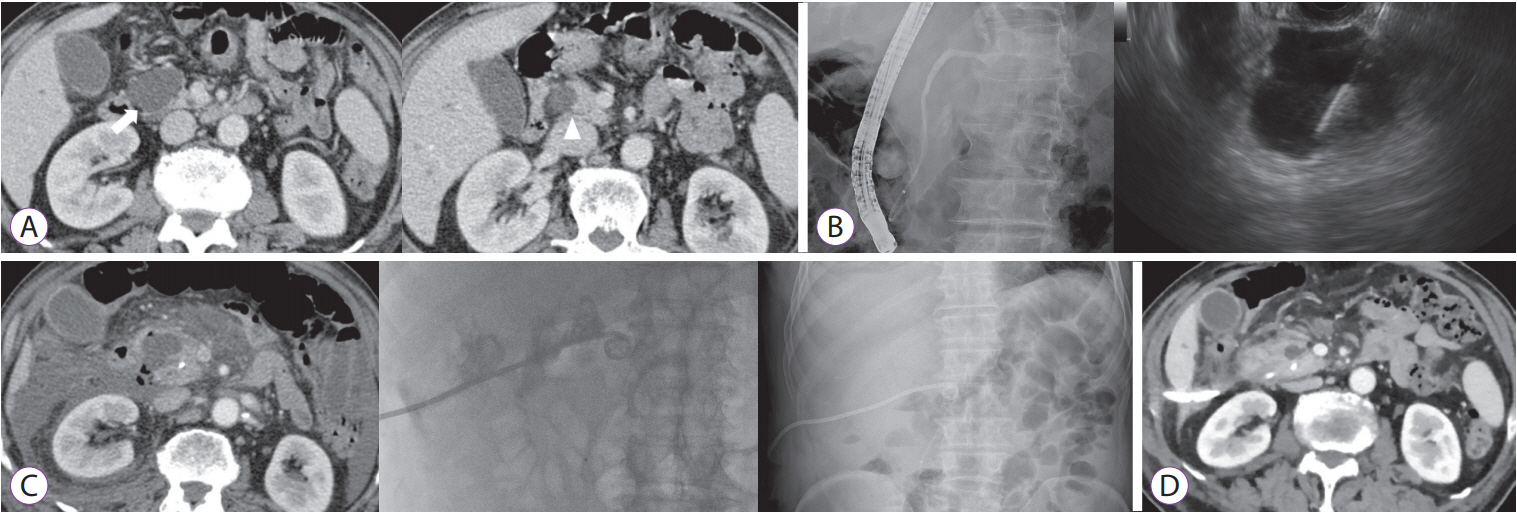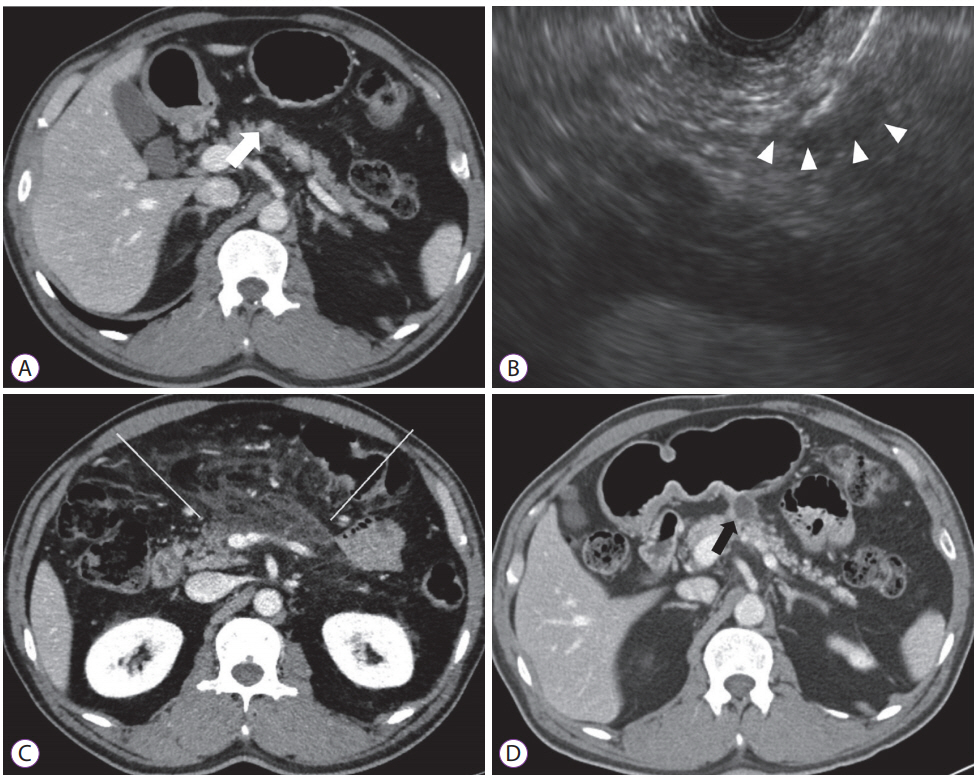Clin Endosc.
2018 May;51(3):229-234. 10.5946/ce.2018.063.
Future Perspectives on Endoscopic Ultrasonography-Guided Therapy for Pancreatic Neoplasm
- Affiliations
-
- 1Department of Internal Medicine, Seoul National University Hospital, Seoul National University College of Medicine, Seoul, Korea.
- 2Department of Gastroenterology and Hepatology, Cleveland Clinic, Cleveland, OH, USA. jangs@ccf.org
- KMID: 2414863
- DOI: http://doi.org/10.5946/ce.2018.063
Abstract
- Endoscopic ultrasonography (EUS)-guided therapy with ethanol injection or catheter-based radiofrequency ablation for pancreatic neoplasm has been conducted as a potential alternate treatment modality for patients who are not eligible for surgery. On the basis of the limited number of studies available, EUS-guided ablation therapy with the aforementioned methods for small pancreatic neoplasms has demonstrated promising technical feasibility and safety profiles. To be considered as a legitimate alternative option to surgery, however, EUS-guided ablation therapy must provide a long-term efficacy profile along with the consensus among experts regarding its treatment parameter. This review focuses on the clinical issues and future perspectives of EUS-guided therapy for pancreatic neoplasm.
Keyword
MeSH Terms
Figure
Reference
-
1. de Jong K, Nio CY, Hermans JJ, et al. High prevalence of pancreatic cysts detected by screening magnetic resonance imaging examinations. Clin Gastroenterol Hepatol. 2010; 8:806–811.
Article2. Laffan TA, Horton KM, Klein AP, et al. Prevalence of unsuspected pancreatic cysts on MDCT. AJR Am J Roentgenol. 2008; 191:802–807.
Article3. Dasari A, Shen C, Halperin D, et al. Trends in the incidence, prevalence, and survival outcomes in patients with neuroendocrine tumors in the United States. JAMA Oncol. 2017; 3:1335–1342.
Article4. Haynes AB, Deshpande V, Ingkakul T, et al. Implications of incidentally discovered, nonfunctioning pancreatic endocrine tumors: short-term and long-term patient outcomes. Arch Surg. 2011; 146:534–538.5. Han J, Chang KJ. Endoscopic ultrasound-guided direct intervention for solid pancreatic tumors. Clin Endosc. 2017; 50:126–137.
Article6. Lee SH. [Endoscopic treatment for pancreatic cystic lesions]. Korean J Gastroenterol. 2018; 71:10–17.
Article7. Choi JH, Lee SH, Choi YH, et al. Clinical outcomes of endoscopic ultrasound-guided ethanol ablation for pancreatic cystic lesions compared with the natural course: a propensity score matching analysis. Therap Adv Gastroenterol. 2018; 11:1756284818759929.
Article8. Lee LS, Andersen DK, Ashida R, et al. EUS and related technologies for the diagnosis and treatment of pancreatic disease: research gaps and opportunities-summary of a national institute of diabetes and digestive and kidney diseases workshop. Gastrointest Endosc. 2017; 86:768–778.
Article9. Gómez V, Takahashi N, Levy MJ, et al. EUS-guided ethanol lavage does not reliably ablate pancreatic cystic neoplasms (with video). Gastrointest Endosc. 2016; 83:914–920.
Article10. Oh HC, Seo DW, Song TJ, et al. Endoscopic ultrasonography-guided ethanol lavage with paclitaxel injection treats patients with pancreatic cysts. Gastroenterology. 2011; 140:172–179.
Article11. Oh HC, Seo DW, Lee TY, et al. New treatment for cystic tumors of the pancreas: EUS-guided ethanol lavage with paclitaxel injection. Gastrointest Endosc. 2008; 67:636–642.
Article12. Park JK, Song BJ, Ryu JK, et al. Clinical outcomes of endoscopic ultrasonography-guided pancreatic cyst ablation. Pancreas. 2016; 45:889–894.
Article13. Choi JH, Seo DW, Song TJ, et al. Long-term outcomes after endoscopic ultrasound-guided ablation of pancreatic cysts. Endoscopy. 2017; 49:866–873.
Article14. DeWitt JM, Al-Haddad M, Sherman S, et al. Alterations in cyst fluid genetics following endoscopic ultrasound-guided pancreatic cyst ablation with ethanol and paclitaxel. Endoscopy. 2014; 46:457–464.
Article15. Levy MJ, Thompson GB, Topazian MD, Callstrom MR, Grant CS, Vella A. US-guided ethanol ablation of insulinomas: a new treatment option. Gastrointest Endosc. 2012; 75:200–206.
Article16. Park DH, Choi JH, Oh D, et al. Endoscopic ultrasonography-guided ethanol ablation for small pancreatic neuroendocrine tumors: results of a pilot study. Clin Endosc. 2015; 48:158–164.
Article17. Yang D, Inabnet WB 3rd, Sarpel U, DiMaio CJ. EUS-guided ethanol ablation of symptomatic pancreatic insulinomas. Gastrointest Endosc. 2015; 82:1127.
Article18. Paik WH, Seo DW, Dhir V, Wang HP. Safety and efficacy of EUS-guided ethanol ablation for treating small solid pancreatic neoplasm. Medicine (Baltimore). 2016; 95:e2538.
Article19. Paik WH, Seo DW. Echoendoscopic ablative therapy for solid pancreatic tumors. J Dig Dis. 2017; 18:135–142.
Article20. Cho MK, Choi JH, Seo DW. Endoscopic ultrasound-guided ablation therapy for pancreatic cysts. Endosc Ultrasound. 2015; 4:293–298.
Article21. Lee LS, Wu BU, Banks PA, et al. Utility of commercial DNA analysis in detecting malignancy within pancreatic cysts. JOP. 2013; 15:182–188.22. Correa-Gallego C, Ferrone CR, Thayer SP, Wargo JA, Warshaw AL, Fernández-Del Castillo C. Incidental pancreatic cysts: do we really know what we are watching? Pancreatology. 2010; 10:144–150.
Article23. Chiang AL, Lee LS. Clinical approach to incidental pancreatic cysts. World J Gastroenterol. 2016; 22:1236–1245.
Article24. Jang DK, Song BJ, Ryu JK, et al. Preoperative diagnosis of pancreatic cystic lesions: the accuracy of endoscopic ultrasound and cross-sectional imaging. Pancreas. 2015; 44:1329–1333.25. Del Chiaro M, Segersvärd R, Pozzi Mucelli R, et al. Comparison of preoperative conference-based diagnosis with histology of cystic tumors of the pancreas. Ann Surg Oncol. 2014; 21:1539–1544.
Article26. Park JS, Seo DW, Song TJ, et al. Endoscopic ultrasound-guided ablation of branch-duct intraductal papillary mucinous neoplasms: feasibility and safety tests using porcine gallbladders. Dig Endosc. 2016; 28:599–606.
Article27. Kim MK. Endoscopic ultrasound in gastroenteropancreatic neuroendocrine tumors. Gut Liver. 2012; 6:405–410.
Article28. Nanno Y, Matsumoto I, Zen Y, et al. Pancreatic duct involvement in well-differentiated neuroendocrine tumors is an independent poor prognostic factor. Ann Surg Oncol. 2017; 24:1127–1133.
Article29. Canellas R, Burk KS, Parakh A, Sahani DV. Prediction of pancreatic neuroendocrine tumor grade based on CT features and texture analysis. AJR Am J Roentgenol. 2018; 210:341–346.
Article30. Gan SI, Thompson CC, Lauwers GY, Bounds BC, Brugge WR. Ethanol lavage of pancreatic cystic lesions: initial pilot study. Gastrointest Endosc. 2005; 61:746–752.
Article31. Matthes K, Mino-Kenudson M, Sahani DV, Holalkere N, Brugge WR. Concentration-dependent ablation of pancreatic tissue by EUS-guided ethanol injection. Gastrointest Endosc. 2007; 65:272–277.
Article32. Caillol F, Poincloux L, Bories E, et al. Ethanol lavage of 14 mucinous cysts of the pancreas: a retrospective study in two tertiary centers. Endosc Ultrasound. 2012; 1:48–52.
Article33. DiMaio CJ, DeWitt JM, Brugge WR. Ablation of pancreatic cystic lesions: the use of multiple endoscopic ultrasound-guided ethanol lavage sessions. Pancreas. 2011; 40:664–668.34. DeWitt J, McGreevy K, Schmidt CM, Brugge WR. EUS-guided ethanol versus saline solution lavage for pancreatic cysts: a randomized, double-blind study. Gastrointest Endosc. 2009; 70:710–723.
Article35. Vazquez-Sequeiros E, Maluf-Filho F. Endosonography-guided ablation of pancreatic cystic tumors: is it justified? Gastrointest Endosc. 2016; 83:921–923.36. Armellini E, Crinò SF, Ballarè M, Occhipinti P. Endoscopic ultrasound-guided radiofrequency ablation of a pancreatic neuroendocrine tumor. Endoscopy. 2015; 47 Suppl 1 UCTN:E600–E601.
Article37. Pai M, Habib N, Senturk H, et al. Endoscopic ultrasound guided radiofrequency ablation, for pancreatic cystic neoplasms and neuroendocrine tumors. World J Gastrointest Surg. 2015; 7:52–59.
Article38. Lakhtakia S, Ramchandani M, Galasso D, et al. EUS-guided radiofrequency ablation for management of pancreatic insulinoma by using a novel needle electrode (with videos). Gastrointest Endosc. 2016; 83:234–239.
Article39. Moyer MT, Sharzehi S, Mathew A, et al. The safety and efficacy of an alcohol-free pancreatic cyst ablation protocol. Gastroenterology. 2017; 153:1295–1303.
Article40. Lakhtakia S, Seo DW. Endoscopic ultrasonography-guided tumor ablation. Dig Endosc. 2017; 29:486–494.
Article41. Oh HC, Seo DW, Kim SC. Portal vein thrombosis after EUS-guided pancreatic cyst ablation. Dig Dis Sci. 2012; 57:1965–1967.
Article42. Silviu UB, Daniel P, Claudiu M, et al. Endoscopic ultrasound-guided radiofrequency ablation of the pancreas: an experimental study with pathological correlation. Endosc Ultrasound. 2015; 4:330–335.
Article43. Girelli R, Frigerio I, Salvia R, Barbi E, Tinazzi Martini P, Bassi C. Feasibility and safety of radiofrequency ablation for locally advanced pancreatic cancer. Br J Surg. 2010; 97:220–225.
Article44. Nakai Y, Iwashita T, Park DH, Samarasena JB, Lee JG, Chang KJ. Diagnosis of pancreatic cysts: EUS-guided, through-the-needle confocal laser-induced endomicroscopy and cystoscopy trial: DETECT study. Gastrointest Endosc. 2015; 81:1204–1214.
Article45. Attili F, Pagliari D, Rimbaș M, et al. Endoscopic ultrasound-guided histological diagnosis of a mucinous non-neoplastic pancreatic cyst using a specially designed through-the-needle microforceps. Endoscopy. 2016; 48 Suppl 1:E188–E189.
Article46. Karia K, Waxman I, Konda VJ, et al. Needle-based confocal endomicroscopy for pancreatic cysts: the current agreement in interpretation. Gastrointest Endosc. 2016; 83:924–927.
Article
- Full Text Links
- Actions
-
Cited
- CITED
-
- Close
- Share
- Similar articles
-
- Present and Future of Endoscopic Ultrasound-Guided Tissue Acquisition in Solid Pancreatic Tumors
- Interventional Endoscopic Ultrasonography: Present and Future
- Past, Present, and Future of Gastrointestinal Stents: New Endoscopic Ultrasonography-Guided Metal Stents and Future Developments
- Forward viewing liner echoendoscopy for therapeutic interventions
- Endoscopic Ultrasound-Guided Direct Intervention for Solid Pancreatic Tumors



